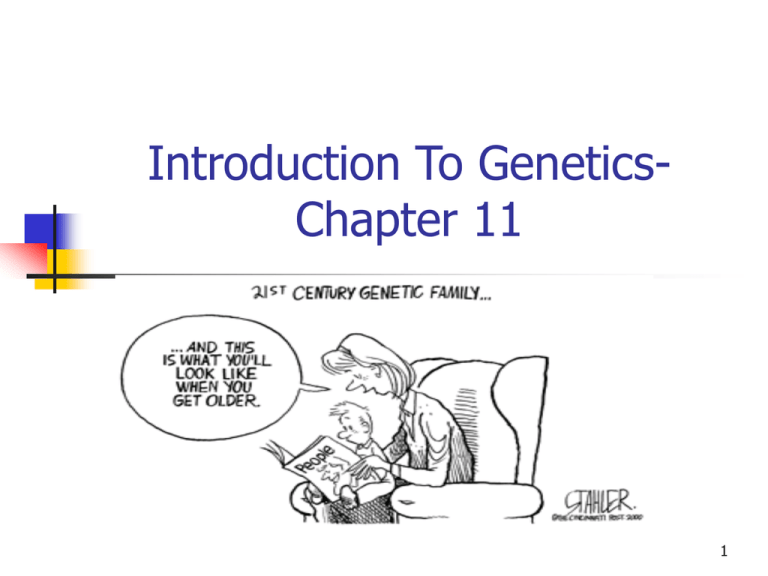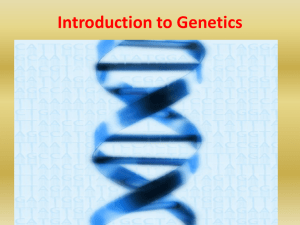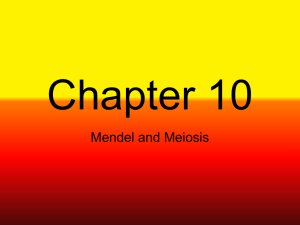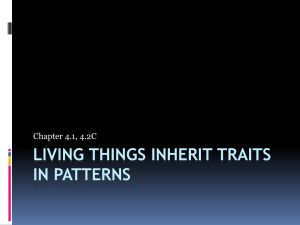
Introduction To GeneticsChapter 11
1
11-1 The Work of Gregor Mendel
I. The work of Gregor Mendel
A. Gregor Mendel was born in 1822
and after becoming a priest; Mendel
was a math teacher for 14 years and a
monastery. Mendel was also in charge
of the monastery garden.
2
11-1 The Work of Gregor Mendel
I. The work of Gregor Mendel
1. Mendel carried out
his work with
garden peas
3
11-1 The Work of Gregor Mendel
I. The work of Gregor Mendel
2. Fertilization is the fusion of an egg
and a sperm.
3. True breeding plants are plants that
were allowed to self-pollinate and the
offspring would be exactly like the
parent.
4
11-1 The Work of Gregor Mendel
I. The work of Gregor Mendel
5
11-1 The Work of Gregor Mendel
Mendel’s experiments
The first thing Mendel did was create a
“pure” generation or true-breeding
generation.
He made sure that certain pea plants
were only able to self pollinate,
eliminating unwanted traits.
He did this by cutting away the stamen,
or male part of each flower
6
11-1 The Work of Gregor
Mendel
Figure
11-3 Mendel’s Seven F1
Crosses on Pea Plants
Mendel’s experiments
Section 11-1
Seed Coat
Color
Pod
Shape
Pod
Color
Smooth
Green
Seed
Shape
Seed
Color
Round
Yellow
Gray
Wrinkled
Green
White
Constricted
Round
Yellow
Gray
Smooth
Flower
Position
Plant
Height
Axial
Tall
Yellow
Terminal
Short
Green
Axial
Tall
*Flower color – purple (P) vs. white (p)
Go to
Section:
Seed coat color and flower color are often put
in for one another – thus, the EIGHT traits!!!
7
11-1 The Work of Gregor Mendel
Genes and dominance
Trait : a characteristic
Mendel studied seven of these traits
After Mendel ensured that his truebreeding generation was pure, he then
crossed plants showing contrasting
traits.
He called the offspring the F1
generation or first filial.
8
11-1 The Work of Gregor Mendel
What will happen when pure yellow
peas are crossed with pure green peas?
All of the
offspring were
yellow.
Hybrids = the
offspring of
crosses between
parents with
contrasting traits
9
11-1 The Work of Gregor Mendel
What did Mendel conclude?
Inheritance is determined by factors
passed on from one generation to
another.
Mendel knew nothing about
chromosomes, genes, or DNA. Why?
These terms hadn’t yet been defined.
10
11-1 The Work of Gregor Mendel
What were Mendel’s “factors”
The ‘factors” that Mendel mentioned
were the genes.
Each gene has different forms called
alleles
Mendel’s second principle stated that
some alleles are dominant and some
are recessive.
11
11-1 The Work of Gregor Mendel
Mendel’s second cross
He allowed the F1 generation to selfpollinate thus producing the F2
generation.
Did the recessive allele completely
disappear?
What happened when he crossed two
yellow pea hybrid (F1) plants?
12
11-1 The Work of Gregor Mendel
Results:
¾ of the peas were yellow, ¼ of
the peas were green.
During the formation of the sex cells or
gametes, the alleles separated or
segregated to different gametes.
(pollen and egg)
13
11-2 Probability and Punnett Squares
Punnett square example
14
11-2 Probability and Punnett Squares
Reading Punnett squares
Gametes are placed above and to the
left of the square
Offspring are placed in the square.
Capital letters (Y) represent dominant
alleles.
Lower case letters (y) represent
recessive alleles.
15
11-2 Probability and Punnett Squares
Phenotype vs genotype
Genotype
The genetic makeup
Symbolized with
letters
Tt or TT
Phenotype
Physical appearance
of the organism
Expression of the
trait
Short, tall, yellow,
smooth, etc.
16
11-2 Probability and Punnett Squares
B. Genes and Dominance
1. The different forms of a gene is
called and an alleles.
2. The principal of dominance states
that some alleles are dominant and
others are recessive.
17
11-2 Probability and Punnett Squares
B. Genes and Dominance
Pinky Finger Traits
At Paris Gibson Ed Center we tested dominant and recessive traits in
our school population. We tested pinky finger traits, whereby, the bent
finger is dominant and the straight finger is recessive.
18
11-2 Probability and Punnett Squares
C. Segregation
1. Each trait has two genes, one from the
mother and one from the father.
2. Traits can be either dominant or recessive.
3. A dominant trait only needs one gene in
order to be expressed.
19
11-2 Probability and Punnett Squares
C. Segregation
4. A recessive trait needs two genes in
order to be expressed.
20
11-2 Probability and Punnett Squares
21
11-2 Probability and Punnett Squares
C. Segregation
5. Egg and sperm are sex cells called
gametes.
6. Segregation is the separation of
alleles during gamete formation.
22
11-2 Probability and Punnett Squares
23
11-2 Probability and Punnett Squares
II. Probability and Punnett
Squares
A. Genetics and Probability
1. The likelihood that a particular
event will occur is called probability.
2. The principals of probability can be
used to predict the outcome of genetic
crosses.
24
11-2 Probability and Punnett Squares
II. Probability and Punnett
Squares
25
11-2 Probability and Punnett Squares
B. Punnett Squares
1. The gene combination that might result
from a genetic cross can be determined by
drawing a diagram known as a Punnett
square.
2. Punnett squares can be used to predict
and compare the genetic variations that will
result from a cross.
26
11-2 Probability and Punnett Squares
27
11-2 Probability and Punnett Squares
B. Punnett Squares
3. Each trait has two genes- one from
the mother and one from the father.
4. Alleles can be homozygous – having
the same traits.
5. Alleles can be heterozygous- having
different traits.
28
11-2 Probability and Punnett Squares
B. Punnett Squares
29
11-2 Probability and Punnett Squares
B. Punnett Squares
6. Physical characteristics are called the
phenotype.
7. Genetic make up is the genotype.
30
11-2 Probability and Punnett Squares
31
11-3 Exploring Mendelian Genetics
III. Exploring Mendalian
Genetics
A. Independent assortment
1. Genes segregate independently.
32
11-3 Exploring Mendelian Genetics
III. Exploring Mendalian
Genetics
2. The principle of independent assortment
states that genes for different traits can
segregate independently during the formation
of gametes.
3. Independent assortment helps account for
the many genetic variations observed in
plants, animals and other organisms.
33
11-3 Exploring Mendelian Genetics
34
11-3 Exploring Mendelian Genetics
The dihybrid cross
Punnett square on board:
35
11-3 Exploring Mendelian Genetics
B. A summary of Mendel’s
Principals
1. Genes are passed from parent to
offspring.
2. Some forms of a gene may be
dominant and others recessive.
36
11-3 Exploring Mendelian Genetics
B. A summary of Mendel’s
Principals
3. In most sexually producing organisms,
each adult has two copies of each gene- one
from each parent. These genes are
segregated from each other when gametes
are formed.
4. The alleles for different genes usually
segregate independently of one another.
37
11-3 Exploring Mendelian Genetics
C. Beyond Dominance and
Recessive alleles
1. Some alleles are neither dominant
nor recessive, and many traits are
controlled by multiple alleles or multiple
genes.
2. Cases in which one allele is not
completely dominant over another are
called incomplete dominance.
38
11-3 Exploring Mendelian Genetics
Incomplete dominance
A situation in which neither allele is
dominant.
When both alleles are present a “new”
phenotype appears that is a blend of
each allele.
Alleles will be represented by capital
letters only.
39
11-3 Exploring Mendelian Genetics
Incomplete dominance
Example: White (W) and Red (R) is both
dominate. If WW X RR the F1
generation would be WR= pink.
40
11-3 Exploring Mendelian Genetics
What happens when a red flower
is crossed with a white flower?
According to
Mendel either
some white and
some red or all
offspring either
red or white.
All are pink
41
11-3 Exploring Mendelian Genetics
42
11-3 Exploring Mendelian Genetics
C. Beyond Dominance and
Recessive alleles
3. Codominance is when both alleles
contribute to the phenotype.
Example: Feather colors
43
11-3 Exploring Mendelian Genetics
C. Beyond Dominance and
Recessive alleles
4. Many genes have more than two
alleles and are referred to have multiple
alleles.
a. This means that more than two
possible alleles exist in a population.
Example: colors of rabbits see page
273.
44
11-3 Exploring Mendelian Genetics
C. Beyond Dominance and
Recessive alleles
45
11-3 Exploring Mendelian Genetics
C. Beyond Dominance and
Recessive alleles
5. Traits that are controlled by two or
more genes are said to be polygenic
traits, which means, “having many
genes.”
a. Example: eye color has many
different genes.
46
Meiosis
Division of Sex Cells
47
11-4 Meiosis
The Point of Meiosis
Meiosis is a process of reduction
division in which the number of
chromosomes per cell is cut in half
through the separation of homologous
chromosomes in a diploid cell.
48
11-4 Meiosis
2 types: Spermatogeneis &
Oogenesis
49
11-4 Meiosis
Meiosis
Diploid – 2 sets of chromosomes
Haploid – 1 set of chromosomes
Homologous – chromosomes that each
have a corresponding chromosome from
the opposite sex parent
50
11-4 Meiosis
Meiosis
51
11-4 Meiosis
IV. Meiosis
A. Chromosome number
1. Every individual has two sets of
chromosomes. One from the mother
one from the father. When the
chromosomes pair up for the same trait
they are called homologous
chromosomes.
52
11-4 Meiosis
IV. Meiosis
2. A cell that contains homologous
chromosomes (2 genes) is said to be
diploid/ 2n.
3. Gametes (egg /sperm) have only
one chromosome and are said to be
haploid/ n.
53
11-4 Meiosis
IV. Meiosis
Meiosis I- The homologous chromosomes line
up BUT then they CROSS OVER, exchanging
genetic information.
Meiosis II- The two cells produced by meiosis I
now enter a second meiotic division. The final
product = start with 1 cell with 46
chromosomes and get 4 DIFFERENT cells each
with 23 chromosomes.
54
11-4 Meiosis
55
11-4 Meiosis
Meiosis Stages
Meiosis usually involves 2 distinct
stages
Meiosis I (animation)
Meiosis II (animation)
56
11-4 Meiosis
57
11-4 Meiosis
58
11-4 Meiosis
Prophase I
Each chromosome pairs with its
corresponding homologous chromosome to
form a tetrad.
There are 4 chromosomes in a tetrad.
The pairing of homologous chromosomes is
the key to understanding meiosis.
Crossing-over may occur here
Crossing-over is when chromosomes overlap
and exchange portions of their chromatids.
59
11-4 Meiosis
60
11-4 Meiosis
Prophase I
61
11-4 Meiosis
Metaphase I
Spindle fibers attach to the
chromosomes
62
11-4 Meiosis
Metaphase I
63
11-4 Meiosis
Anaphase I
The fibers pull the homologous
chromosomes toward opposite ends of
the cell.
64
11-4 Meiosis
Anaphase I
65
11-4 Meiosis
Telophase I & Cytokinesis
Nuclear membranes form.
The cell separates into 2 cells.
66
11-4 Meiosis
Telophase I
67
11-4 Meiosis
Prophase II
Meiosis I results in two haploid (N)
cells.
Each cell has half the number of
chromosomes as the original cell.
68
11-4 Meiosis
Prophase II
69
11-4 Meiosis
Metaphase II
The chromosomes line up similar to
metaphase in mitosis.
70
11-4 Meiosis
Metaphase II
71
11-4 Meiosis
Anaphase II
Sister chromatids separate and move to
opposite ends of the cell.
72
11-4 Meiosis
Anaphase II
73
11-4 Meiosis
Telophase II
Meiosis II results in 4 haploid cells.
74
11-4 Meiosis
Telophase II
75
11-4 Meiosis
Gamete Formation
In males, meiosis results in 4 sperm
cells
In females, meiosis results in 1 egg cell
and three polar bodies, which are not
used in reproduction.
76
11-4 Meiosis
Net result:
Spermatogensis
4 mature sperm
Each sperm has
exactly half the
number of
chromosomes as the
father.
Oogensis
1 mature ova or
egg.
Each egg has
exactly half the
number of
chromosomes as the
mother.
77
11-4 Meiosis
2 types: Spermatogeneis &
Oogenesis
78
11-4 Meiosis
Mitosis vs Meiosis
Results in
Cells are
Occurs in
Mitosis
2 Diploid Cells
(2N)
Genetically
Identical
Somatic (Body)
Cells
Meiosis
4 Haploid Cells
(N)
Genetically
Different
Sex Cells
79
11-5 Linkage and Gene Maps
V. Linkage and gene maps
A. Gene linkage
1. Thomas Hunt Morgan research on
fruit flies led him to the principal of
linkage.
2. Morgan discovered that many genes
appeared “linked” together.
80
11-5 Linkage and Gene Maps
V. Linkage and gene maps
81
11-5 Linkage and Gene Maps
V. Linkage and gene maps
3. It is the chromosomes, however,
that assort independently not individual
genes.
4. Mendel DID miss gene linkage.
82
11-5 Linkage and Gene Maps
V. Linkage and gene maps
5. Even though if two genes are found
on the same chromosome this does not
mean they are linked forever. Crossing
over can occur.
6. Crossing over creates genetic
diversity.
83
11-5 Linkage and Gene Maps
V. Linkage and gene maps
7. A gene map
shows the relative
location of each
gene. See page 280
figure 11.9
84
11-5 Linkage and Gene Maps
85
Alleles, alternative versions of a gene
86
87
Pedigree analysis
88
Testing a fetus for genetic disorders
89









